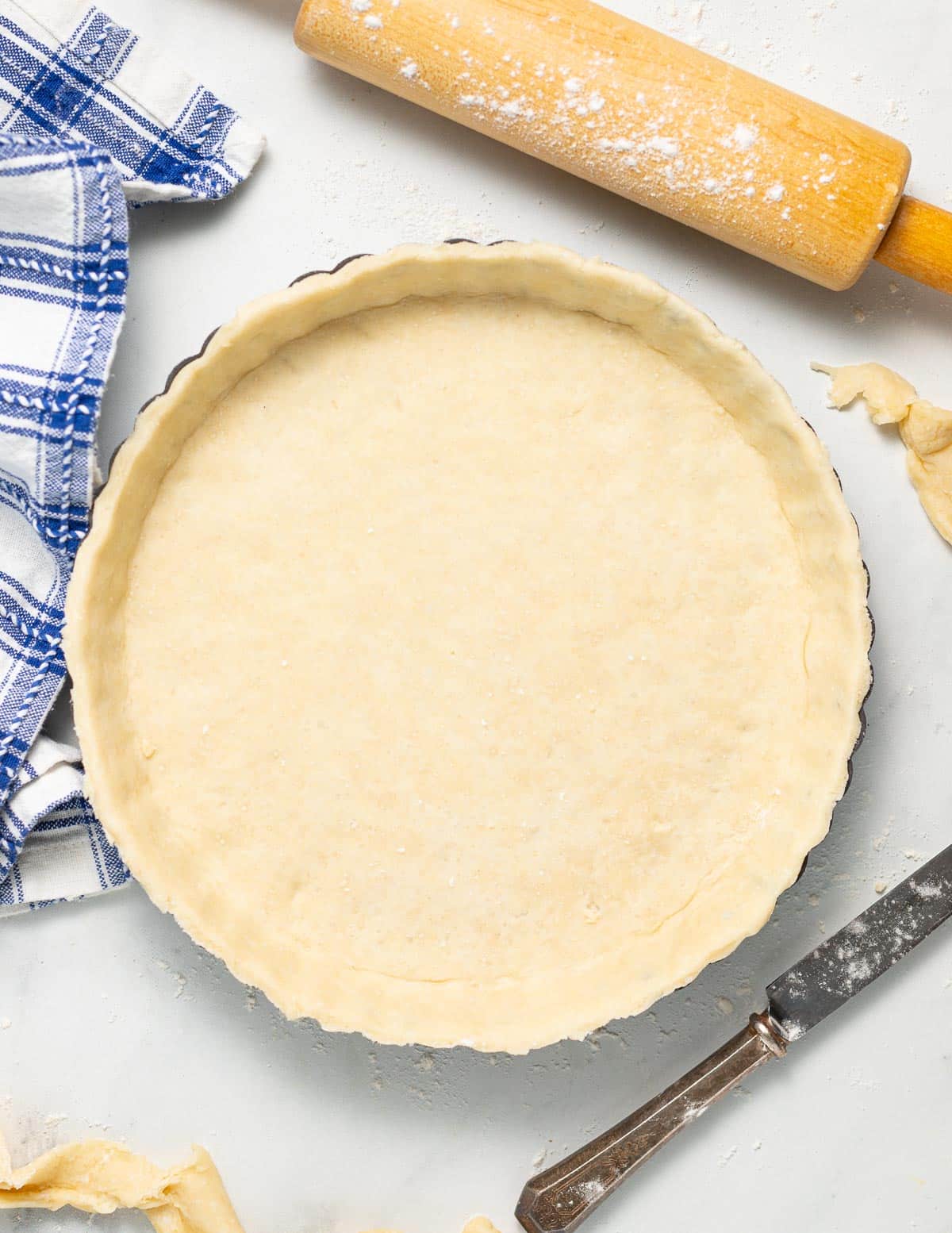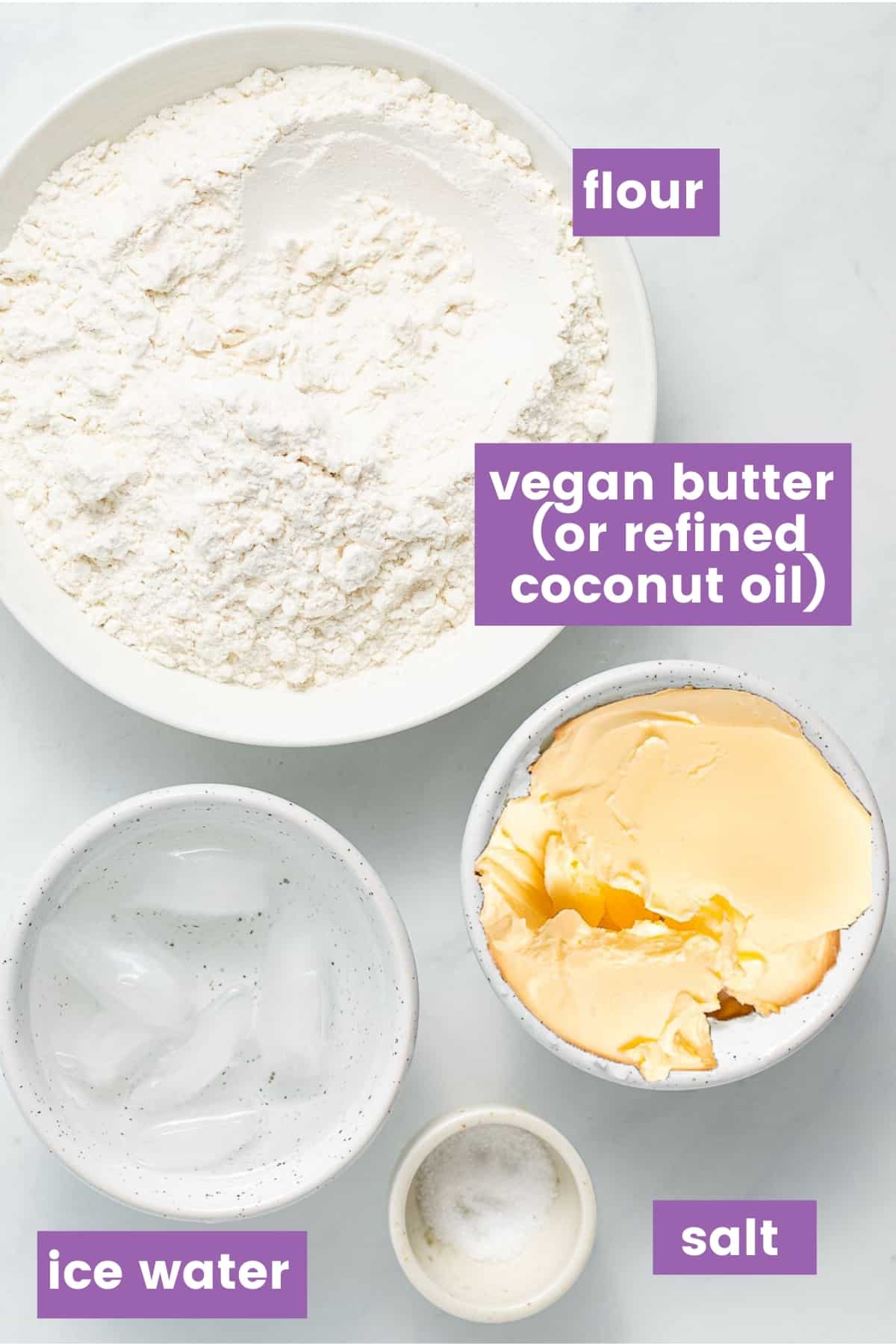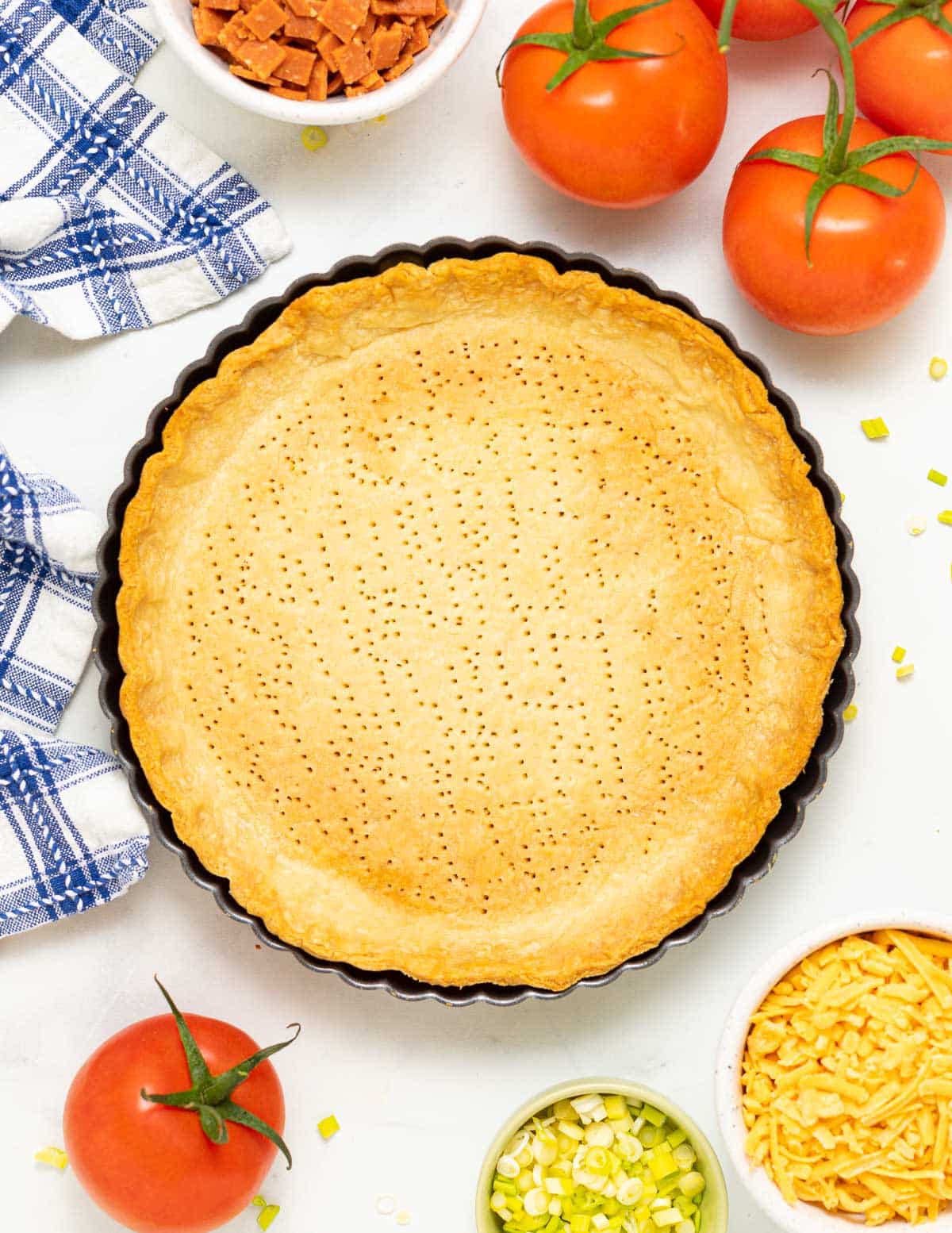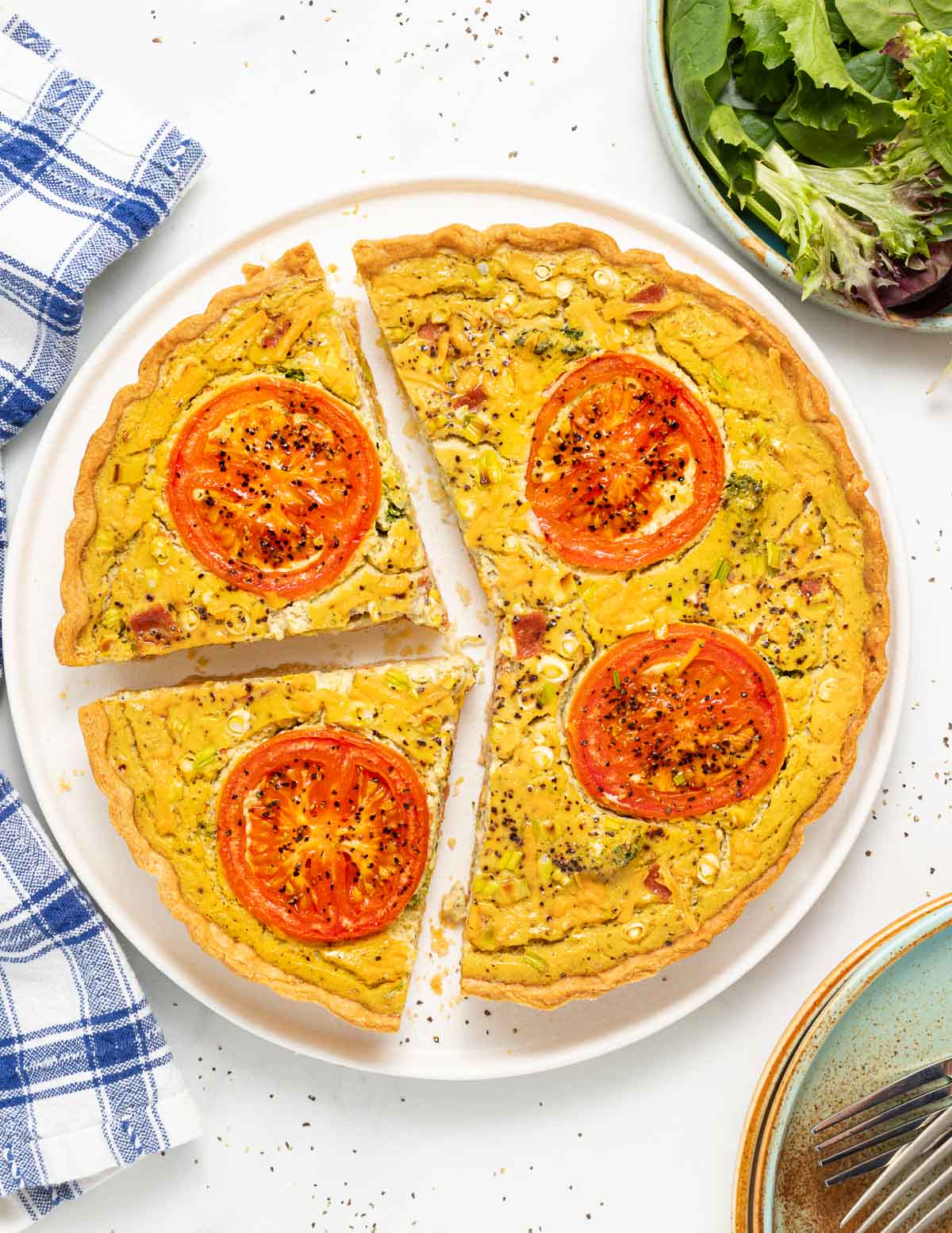Learn how to make an easy, perfectly tender, flaky, and crispy vegan pie crust with my easy step-by-step recipe. This vegan shortcrust pastry is suitable for sweet or savoury pies with either cooked or no-cook fillings, tarts, pot pie crusts, quiches, pastries, Cornish pasties, and galettes.

💌 SAVE THIS RECIPE!
Watch out for more tasty treats coming your way too! Unsubscribe at any time.
This buttery, flaky, and tender vegan pie crust has been my go-to recipe for years and years and comes complete with all of my tips and troubleshooting.
In this post:
This recipe makes one pie crust suitable for a top or bottom. If you want to make a double-crusted pie simply double the recipe. There are 1X, 2X, and 3X buttons in the recipe card that will alter the quantities for you automatically, so no need to do the math yourself!
My vegan shortcrust pastry recipe is well worth mastering because it can be used again and again for all of your savoury or sweet pies, including vegan quiche, pot pie crusts, tarts, pastries, vegan pecan pie, pasties, and galettes, whether they have cooked or uncooked fillings.
If you are looking for a healthier vegan pie crust recipe, be sure to check out my amazing healthy pie crust recipe that uses no oil, shortening, or vegan butter.
What is shortcrust pastry?
"Shortcrust" refers to the baking term "short". This means that there is a high proportion of fat to flour and very minimal gluten development. When the fat gets cut into the flour, the gluten strands get coated in it, which along with minimal handling, keeps them very short. This ensures that the pastry is flaky and tender enough to cut easily, but that it will be fairly sturdy and won't disintegrate into crumbs when cut.
As well as coating the gluten strands, the tiny pieces of fat melt into the hydrated flour, creating flakiness and crispness. And that is why it is really important to keep everything cold when making pastry. We need to keep the fat in a solid state until the crust goes into the oven so we get tender flaky layers when it is baked, in a similar (but less evident way) to when we bake biscuits.
Ingredients
Here are the ingredients you need at a glance:

This vegan pie crust is made with 4 ingredients. Each ingredient has a very specific job, so when making this vegan pie pastry it is important to not make any subs and to be precise with your measurements. I highly recommend the use of a digital scale for measuring the flour and butter. Cups are not accurate enough for the best and most consistent results when baking.
- Flour - Use all-purpose flour, and if you are in the UK use plain flour. The recipe will also work with wholewheat flour but the pastry won't be as short or flaky and there will be that signature "wholewheat" taste.
- Salt - For flavour. Use fine salt instead of coarse salt so it disperses evenly throughout the dough.
- Vegan butter - This vegan pie crust is made with no shortening. Butter gives it an unbeatable buttery flavour and a flaky texture. The butter must be very cold and hard. Soft margarine-style vegan butter like Becel and Flora in a tub won't work well. It must be hard when cold like my butter recipe, Earth Balance, Miyokos, or the Flora block butter. Refined coconut oil can also be used but it doesn't give as good a flavour as butter. Note that if you use coconut oil, it must be refined so the pastry doesn't end up tasting/smelling like coconut.
- Ice water - The amount of water needed varies every time. Add plenty to a jug or glass and add a big handful of ice to really chill it. Use just enough of the icy water so the dough holds its shape but will be easily rollable. By using iced water you keep the fat in the pastry very cold which will make the pastry easier to handle and give it a better texture once cooked.
OPTIONAL Sugar - White sugar or cane sugar is best. Add this to the recipe if you are making a sweet pie or tart and would like a sweetened pie crust.
How To Make Vegan Pie Crust
Vegan Pie Crust is really easy to make in just a couple of steps. Using a food processor, the dough takes just a few minutes to make but you can also make it easily by hand.
Here's how it's done:

- Add the flour, salt, and butter to a food processor or a bowl if you don't have a food processor.
- Pulse (or cut in) until you have a coarse breadcrumb texture.
- Add iced water very gradually until the vegan pastry dough has enough moisture to come together.
- Roll out carefully.

Once the dough is made:
- Gently place the pastry over the pie dish or tart/quiche pan. Press in tightly with a little ball of excess dough to avoid touching with your hands, then trim the edges with a knife. By using the ball of dough, the heat from your hands won't be in contact with the pastry so won't melt the fat in the dough.
- If using a pie dish crimp the edges. If using a tart/quiche pan use the ball of discarded dough to push the sides up a few millimetres above the rim. This is insurance against any shrinking.
- Prick the bottom all over with a fork so you don't get any bubbles when it bakes.
- Scrunch up a sheet of parchment paper and line the pie crust with it, then fill with baking beans, dried rice or dried beans and blind bake or completely bake depending on what type of filling you are using.
When the pie is being filled with a no-cook filling it is essential to fully bake the pie crust and cool it completely before adding the filling. For pies that will go back in the oven, like quiche or pumpkin pie, the crust can still be warm when you add the filling.

Success Tips
For the very best results when making this recipe follow these tips:
- Use ice-cold water. Fill a glass or jug with water and add a good handful of ice cubes.
- Use very cold vegan butter or coconut oil.
- Don't handle the pastry dough with your hands any more than absolutely necessary. They are warm and will melt the fat.
- Use a piece of balled-up scrap pastry dough to mould the pastry into the sides of the pie dish rather than using your fingers. This helps to keep it cool.
- Prevent crumbly pastry by making sure you use enough water when mixing it up. Too little water will make your dough very difficult to work with.
- If it's summer or your kitchen is particularly warm, chill the flour and all bowls/utensils before starting.
- Roll the dough so it is a bigger circle than the diametre of your pie dish. You can lift up your dish over the rolled pastry to see if it is big enough. It should be at least 2 or 3 inches wider all around so there is plenty to cover it and go up and over the sides.
- Once you have lined your pie dish, chill well before blind baking or baking. This step is absolutely essential to avoid shrinkage.
- When lining the pie crust with parchment paper, cut a piece the size you need then screw it up in your hands really tightly like you are going to throw it in the trash. then straighten it out and push it gently over and into the pie crust. It makes it much easier to fit it in there without damaging the pastry.
- Prevent a tough baked pie crust. This can be caused by not using enough fat in the crust (be sure to weigh and measure accurately with a digital scale) and/or by overworking the dough. Handle as little as possible and keep the dough cold.
- Before pouring a wet filling into a blind-baked crust, brush the entire surface of the pastry with a very thin coating of oil. This forms a protective barrier and stops the liquid from seeping into the pastry.

Blind-Bake Or Fully Bake?
If the pie recipe you are following calls for a fully baked pie crust, you need to fully bake this vegan pie crust recipe. If it calls for a blind-baked or par-baked shell then you need to blind-bake (par-bake) it. Instructions are included in this recipe for both methods.
Recipes where the filling going into the pie is wet and has a tendency to make the bottom soggy, like my vegan pumpkin pie and vegan quiche recipe, or recipes where the filling needs a shorter bake time than the crust, require a blind-baked pie crust. By blind-baking, you get a nice crisp crust and reduce the chances of a soggy bottom.
Making In Advance
Here is how to make vegan pastry dough in advance:
- Uncooked and unrolled pastry dough - Make the vegan pie dough up to 3 days ahead. Place in a tightly sealed freezer bag, or airtight container, or wrap tightly and thoroughly in cling wrap and place in the fridge until needed. It can also be frozen for up to 3 months. Defrost overnight in the fridge. You might need to leave it out at room temperature for a few minutes to warm and soften very slightly before rolling it.
- Rolled, lined, and uncooked - After lining the pie dish you can carefully store it in the fridge for up to 5 days or the freezer for up to 3 months. Be sure to cover it tightly so it doesn't dry out and be very careful it doesn't get knocked while in the fridge or freezer. Blind-bake or cook it completely straight from the fridge or freezer. Add an extra minute onto the bake time if it's coming from the freezer.
- Blind-baked or completely baked - Stored in an airtight container in the pantry for up to 4 days.

Recipe FAQs
It should work well with a good all-purpose gluten-free flour like Bob's Red Mill 1 for 1.
This recipe will not work without the butter/coconut oil but I do have an oil-free healthy pie crust recipe.
Keep the pastry very cold at all times and don't skip the chilling step before baking it. Use pie weights (like baking beans or dried rice) because they prevent the bottom of the crust from puffing up and also help prevent the sides from shrinking down. If using a quiche or tart pan, when lining it, push the pastry up a few millimetres over the top of the pan before blind-baking. This acts as shrink insurance and is easy to trim off with a sharp knife after baking if no shrinkage occurs.
Blind-bake or fully bake the crust as per my instructions before filling it. This makes the pastry drier and liquid doesn't absorb into it as easily so it stays crisper. Another step that really helps when a wet filling is being used, is brushing the crust all over with a very thin coat of oil (olive, canola, vegetable, or sunflower oil) before adding the filling. The oil creates a protective barrier and stops the liquid from seeping into the pastry.
Excess pastry can be wrapped tightly and stored in the fridge for a couple of days or frozen for 3 months. I like to make a few jam tarts with mine! Roll it out, cut into rounds, line a muffin pan with the rounds, fill ¾ way up with jam then bake until golden and bubbly! Cool in the pan and don't try eating them while the jam is hot.
Recipe

Vegan Pie Crust
Author:WATCH HOW TO MAKE IT
Ingredients
- 2 cups (250 grams) all purpose flour , (plain flour in the UK)
- ½ teaspoon fine salt
- ½ cup + 1 tablespoon (120 grams) vegan butter , or refined coconut oil. The butter or coconut oil must be very cold and hard.
- about ½ cup (120 mls) iced water
OPTIONAL (only for a sweet crust)
- ¼ cup (50 grams) white or cane sugar
RECOMMENDED EQUIPMENT
INSTRUCTIONS
With a food processor
- To a food processor add the flour and salt (and optional sugar if you are making a sweet crust).
- Add the butter to the food processor and pulse a few times until the mixture looks like very coarse bread crumbs. You should be able to visibly see small lumps of butter.
- Gradually add the ice-cold water (making sure no ice cubes fall in), pulsing the food processor until there is enough moisture for the dough to come together. You might not need all of the water. You might need a teeny tiny bit more. It varies a little every time.
- Remove the blade and use your hands to bring the pastry dough together then turn out onto a well floured, clean surface. It should come together easily and feel pliable and soft.
- Sprinkle the top of the pastry with a light dusting of flour and roll out to 2 or 3 inches larger than your pie/quiche/tart dish.
- Lift carefully by partially rolling the rolled out pastry around the rolling pin, and gently lower into the dish.
- Use a scrap of pastry from the overhang to roll into a small ball and use it to push the dough into and up the sides of the pan. The less you handle it with your hands the better. The ball of dough stops your body heat from melting the fat in the dough.
- Trim around the edges with a sharp knife or crimp if you are lining a pie dish. If you are lining a quiche/tart pan, use the ball of dough again to push the edges up just a tiny bit (a few millimetres at most) above the rim of the pan. This helps compensate for any shrinkage that might occur.
- Prick all over the bottom of the crust with a fork, then place the pastry crust in the fridge for 30 minutes or the freezer for 15 minutes. There is no need to cover it unless you are storing it for longer (details RE storing for longer are in the recipe notes).
To make by hand
- Add the flour and salt (and optional sugar if you are making a sweet crust) to a bowl and mix them up to combine.
- Cut the butter into smaller chunks and add it to the flour mixture, cut it in either with a pastry cutter or a fork until it looks like coarse bread crumbs.
- Gradually add the ice-cold water (making sure no ice cubes fall in), stirring with a knife until the dough starts coming together. You might not need all of the water and you might need a teeny tiny bit more. It varies a little each time.
- Use your hands to bring the pastry dough together (but don't handle too much). It should come together easily and feel pliable and soft. Turn it out onto a well floured, clean surface.
To blind-bake
- Preheat oven to 400°F (200 °C) with a metal baking sheet or tray big enough to fit your pie dish on in there as it preheats.
- Line the chilled pie crust with parchment paper. Cut a piece the size you need then screw it up in your hands really tightly like you are going to throw it in the trash. then straighten it out and push it gently over and into the pie crust. It makes it much easier to nestle it in there nicely.
- Fill with baking beans, dried beans or dried rice and put on the preheated tray in the oven. Bake for about 17 minutes or until the edges of the crust are just beginning to turn a gentle golden brown.
- Remove from the oven and gently lift out the parchment paper along with the baking beans/rice. Then return to the oven and bake for around 7 to 8 minutes more, or until the bottom of the crust is just beginning to turn a gentle golden brown. Remove from the oven and allow to cool.
To fully bake
- Follow the blind-baking instructions but when you remove the parchment paper and baking beans/rice, then return it to the oven, bake for about 15 to 16 minutes or until the bottom crust is golden brown. Remove from the oven and allow to cool.
NOTES
- Uncooked and unrolled pastry dough - Make the vegan pie dough up to 3 days ahead. Place in a tightly sealed freezer bag, airtight container or wrap tightly and thoroughly in cling wrap and place in the fridge until needed. It can also be frozen for up to 3 months. Defrost overnight in the fridge. You might need to leave it out at room temperature for a few minutes to warm and soften very slightly before rolling it.
- Rolled, lined and uncooked - After lining the pie dish you can carefully store it in the fridge for up to 5 days or the freezer for up to 3 months. Be sure to cover it tightly so it doesn't dry out and be very careful it doesn't get knocked while in the fridge or freezer. Blind-bake or cook it completely straight from the fridge or freezer. Add an extra minute onto the bake time if it's coming from the freezer.
- Blind-baked or completely baked - Stored in an airtight container in the pantry for up to 4 days.
💌 SAVE THIS RECIPE!
Watch out for more tasty treats coming your way too! Unsubscribe at any time.


Sue says
Chose this recipe because the tips are the same as I’ve heard from real chefs. It was very light and delicious. Really good pastry. I used the coconut oil and I worried about it being too much but the pastry was so good and delicate. It was a savoury pastry I made and the only change I would make would be to add a little more salt but I know that is a personal taste issue.
Melanie McDonald says
Thanks so much for leaving a review, Sue. I'm really pleased you enjoyed it!
Janice says
Can I make this gluten-free?
Melanie McDonald says
Sorry, I haven't tested this recipe with gluten-free flour. This one has been tested with it and works great though: https://avirtualvegan.com/healthy-pie-crust/